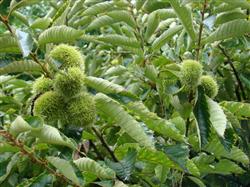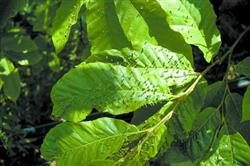How to make Chinese chestnut fruitful?

How to make Chinese chestnut fruitful? Please introduce the method so that the high yield of the planted chestnut can be referred to the following methods: first, close planting can not only increase the early yield and obtain economic benefits as soon as possible, but also facilitate intensive management of the orchard. Planting density: the plant row spacing is generally 2m × 4m and 3m × 4m or 3m × 5m. The specific density depends on the characteristics of rootstock, scion or site conditions. The investment in building the garden can be recovered within 6 years after planting. Mountain areas can dig fish scale pits or horizontal trenches according to contours as planting holes (ditches); flat land can dig planting ditches according to row spacing, with a depth of 1 m and width of 1 m, and the bottom layer is filled with a mixture of topsoil and organic fertilizer, about 8% full, with the remaining space for storing rain and snow, and planting in spring after weathering and ripening. 2. Soil, fertilizer and water management Castanea mollissima is a deep-rooted plant with strong tolerance to drought and barren. Generally, it is only watered in the planting hole when it is planted, and there is no need to water it after it survives. On the basis of applying base fertilizer in autumn, chestnut trees are topfertilized 3 times during the growing period. The amount of base fertilizer applied in autumn is 100 kg of organic fertilizer per plant and a small amount of chemical fertilizer. It can be combined with the deep turning of the orchard to spread fertilizer throughout the orchard (in the case of sufficient fertilizer) or radial fertilization in annular trenches. Topdressing can be carried out before sprouting, flowering and rapid fruit growth respectively. Ditch or hole application can be carried out, the amount of urea or compound fertilizer per plant is 0.5% 0.6 kg, or 0.3% urea solution is sprayed on the leaf, and the fruit setting rate can be increased by 8% by 0.2% boron fertilizer solution at flowering stage. Third, the main purpose of shaping and pruning young trees is to cultivate tree types, and it is necessary to grasp the principle of "light rather than heavy, less sparse and not cut, and winter pruning as a supplement", speed up the expansion of the crown, increase the number of effective branches, and achieve early fruit and early high yield. Generally remove the inner dense branches, overgrown branches, thin and weak branches, retain strong branches, in order to cultivate into backbone branches, branch groups or fruiting mother branches, and adjust the angle and proportion of the above branches. Individual overlong shoots should also be properly truncated to facilitate shaping and promote effective branching. The extended branches of the backbone branches can be released slowly for one year and cut short for two years. After entering the fruiting period, it is necessary to maintain the strong tree potential, prolong the fruiting period (especially the full fruiting period), concentrate effective nutrition, maintain the strong tree potential, and pay attention to selecting the strong branches inside the chamber to culture into fruiting mother branches, so as to achieve the three-dimensional fruit of the whole tree crown. in order to achieve the goal of high and stable yield. For over-growing fruiting trees, they should leave more branches and cut less, so as to disperse the nutrition of the tree and ease the growth potential. For strong fruiting mother branches, they should be trimmed gently, with less shrinkage and more expansion, and 5 branches can be retained on each 2-year-old branch. After fruiting branches in the same year, the moderate fruiting mother branches are not easy to form new fruiting mother branches, so they should be thinned properly. For the fruiting mother branches which are very poor in fruit setting ability and have shown senescence, they should be thinned or retracted in time in order to promote the development of new branches and cultivate them into fruiting mother branches. For the treatment of fruiting branches, about 15 fruiting branches per square meter of crown projection area can be retained before canopy joining, and after crown joining, about 12 fruiting branches can be retained, and the distance between branches is about 30cm-40cm. Fourth, pest control 1. Ploughing the soil in early spring can eliminate a variety of overwintering soil larvae, such as chestnut weevil, pruning weevil and so on. 2. Chemical control combined with scraping bark, and using dichlorvos kerosene solution (kerosene 1: 1.5 kg + 80% dichlorvos 50 g), or drying with 40% dimethoate emulsion 10 times, 50% monocrotophos emulsion 20 times solution, can eliminate tree trunk overwintering pests, such as chestnut wing moth, chestnut leaf mite and so on, the effect is better after drying with plastic film. 3. The galls on the branches and leaves of the new shoots were cut off and destroyed in time from late April to early May, which could reduce the population density of chestnut gall wasp and effectively control the harm of chestnut gall wasp. 4. According to the occurrence from late May to September, 2.5% deltamethrin 6000 times, or 75% phoxim 1000m 2000 times, 90% trichlorfon 800Mel 1000 times, 50% monocrotophos 3000 times, canopy 2Mel 4 times, can kill a large number of adults of various pests. Click to get more chestnut planting techniques click to get more fruit planting techniques
- Prev

Is there any way to promote the fruiting of chestnut?
Is there any way to promote the fruiting of chestnut? To promote the fruiting of Chinese chestnut, please refer to the following methods: first, increasing the application of boron fertilizer has achieved remarkable results, combined with the application of chemical fertilizer, each chestnut is evenly mixed with 100ml 150g borax into urea, about 1 meter from the tree trunk. Dig a strip with a depth of 15 cm and a width of 20 cm.
- Next

What are the main pests of Chinese chestnut?
What are the main pests of Chinese chestnut? Please introduce the occurrence characteristics and control methods of chestnut gall wasp and cloud spot longicorn beetle as follows: first, chestnut gall wasp 1. The morphological characteristics of adults are black wasps, with a body length of 2mi 3mm and transparent front and rear wings. The egg is oval, 0.2 mm long, milky white, with a tail.
Related
- Moge, come on! The staff of the peasant association in the producing area of cantaloupe were frightened when the crowd gathered.
- Causes and Solutions of low Fruit setting rate of Apple
- Symptoms and control measures of passion fruit virus disease
- Fruit growing lesson: how do apple orchards keep high yields?
- Can you build orchards in the mountains? What are the pros and cons?
- How to manage the coloring period of Crisson grape?
- This paper introduces the processing technology of two kinds of fig products.
- How much is a month for retired teachers in rural areas by 2020?
- How can strawberry planting increase sugar content? We should pay attention to management in many aspects.
- What are the cultivation techniques on how to improve the yield of golden fruit?

